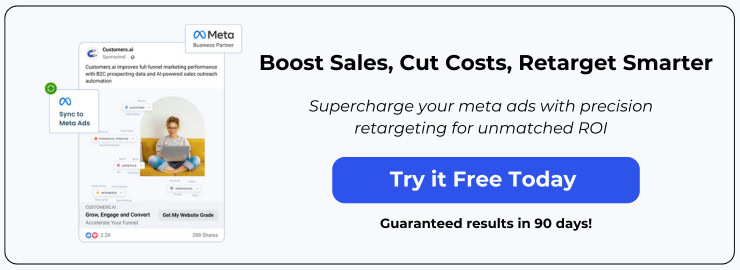If you’ve ever shopped online and then noticed ads following you around the internet for those same products, you’ve experienced retargeting.
This powerful digital marketing tactic allows brands to keep their products top-of-mind for potential customers who have already shown interest.
But not all retargeting strategies are the same. List-based retargeting takes this approach to the next level, making it easier than ever to convert window shoppers into buyers.
What is List-Based Retargeting?
Traditional retargeting relies on tracking cookies to follow users across the web and serve them ads for products they’ve previously viewed.
While this can be effective, it has some major limitations: it only targets users based on a single website visit, ignoring valuable data from other sources; tracking restrictions and ad blockers can prevent cookies from working properly; and there is no way to prioritize or segment your audience for customized campaigns.
List-based retargeting takes a different approach.
Instead of cookies, it utilizes first-party data lists that you own and control. This could include customer email lists, loyalty program members, e-commerce purchasers, and more. By uploading these lists to an ad platform, you can retarget those specific users across all of their devices with ultra-relevant ads.

The Game-Changing Benefits of List-Based Retargeting
So what makes list-based retargeting such a game-changer? Here are some of the key advantages:
-
Improved Audience Targeting
With list-based retargeting, you can be laser-focused on your highest-value prospects and customers. Rather than spraying ads to anyone who happens to visit your site, you control exactly which audiences you want to target based on real data about their interests and purchase behavior. -
Higher Conversion Rates
Because list-based audiences contain users with a demonstrated connection to your brand, they are much more likely to convert when served relevant ads. You’re hitting the right people with the right message at the perfect time. -
Better ROI
By eliminating wasted ad spend on irrelevant audiences, list-based retargeting campaigns drive much higher returns. You’re only paying to reach the most qualified prospects who have the highest potential lifetime value. -
Unified Customer View
List-based retargeting allows you to combine data from multiple sources like email lists, CRMs, and e-commerce platforms. This creates a unified view of the customer that enables precise segmentation and personalization. -
Omnichannel Reach
Customer lists can be deployed across all major ad channels — search, social, display, video, etc. This omnichannel approach ensures your brand stays top-of-mind wherever your audiences are engaging online. -
Regulatory Compliance
Uploading first-party data that customers have willingly provided ensures your retargeting efforts comply with data privacy regulations like GDPR and CCPA.
Best Practices for Successful List-Based Campaigns
To get the most out of list-based retargeting, follow these best practices:
-
Build robust first-party data assets through lead magnets, content marketing, email capture and more. The richer your data, the more effective your targeting will be.
-
Segment your lists based on demographics, behaviors, purchase cycles and other relevant criteria. This allows you to serve hyper-relevant ads to each group.
-
Create tailored ad creative and messaging to resonate with each audience segment. Generic one-size-fits-all campaigns will fall flat.
-
Set up sequential retargeting flows to nurture prospects down the funnel with the right message at the right stage.
-
Continuously refresh your lists and exclude existing customers when appropriate to focus on new acquisition.
-
Align retargeting with other marketing channels like email and social for a cohesive, multi-touch brand experience.
-
Rigorously test and optimize your campaigns based on performance data. Constantly tweak audiences, creative and spend allocation.
Key Takeaways
In a world of ad blockers, walled gardens and data privacy concerns, list-based retargeting allows brands to cut through the noise and get their messages in front of their most valuable audiences.
By leveraging first-party data, you can target known prospects and customers, reach people across all their devices, customize messaging for audience segments, and improve ad relevance and ROI.
If you aren’t already utilizing this powerful tactic, it’s time to get on board. List-based retargeting is quickly becoming the gold standard for effective, revenue-driving digital advertising.
By following best practices and continually optimizing your campaigns, you can keep your brand top-of-mind, nurture leads down the funnel, and ultimately drive more sales and customer loyalty.
FAQs
- What is list-based retargeting?
List-based retargeting allows advertisers to upload their own first-party data lists (emails, customers, etc.) to ad platforms and retarget those specific users across the web. - How is list-based retargeting different from traditional retargeting?
Traditional retargeting uses tracking cookies to follow users based on website visits, while list-based retargeting utilizes the brand’s own data to reach known prospects and customers. - What are the benefits of list-based retargeting?
Key benefits include improved audience targeting, higher conversion rates, better ROI, unified customer data, omnichannel reach, and regulatory compliance. - What types of lists can be used for retargeting?
Common list sources include email lists, CRM databases, e-commerce purchaser lists, loyalty program members, and more. - How do I build a list for retargeting?
Grow your lists through lead magnets, content marketing, email capture software, purchases, and other sources of first-party data. - How can I segment my retargeting lists?
Segment by demographics, behaviors, purchase cycles, and other relevant criteria to create tailored campaigns for each audience. - What channels can list-based retargeting be used on?
Lists can typically be deployed across search, social, display, video, and other major ad channels. - Do list-based retargeting campaigns comply with data privacy laws?
Yes, using first-party data that customers have willingly provided ensures compliance with regulations like GDPR and CCPA. - How do I set up a list-based retargeting campaign?
Upload your lists to an ad platform, create tailored ad creative and messaging, set up audience segments and sequential flows. - How can I optimize my list-based retargeting performance?
Continuously refresh lists, test different audiences/messaging, align with other marketing channels, and analyze performance data.

